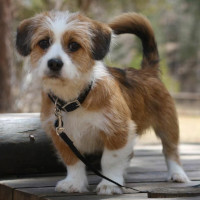Appearance of the Shorgi
|
| Taking physical traits from both its Corgi and Shih Tzu relatives, the Shorgi tends to resemble a Corgi with longer fur and a shorter face. Indeed, most will retain the long body and stocky legs of the Corgi parent. However, there are always exceptions to the rule, and it's impossible to know which genes will be inherited on which side. Medium-sized dogs with stocky bodies and long backs, Shorgi have limbs that seem too short for their stature. They may have the characteristic large ears of the Corgi or the hanging ears of the Shih Tzu. Most will have soft brown eyes, although light blue eyes have been reported. At maturity, the Shorgi will weigh between 9 and 17 kilos and measure between 25 and 33 centimeters at the withers. Although there is generally little variation, males can be slightly larger than their female counterparts. Shorgi coats differ from one individual to the next, even within the same litter. Their coat can be long, straight and smooth, short and dense, or somewhere in between. Coat color can be red, fawn, brown, white or black, and most dogs will have two or three colors in their coat, rather than one solid block color. |
Temperament of the Shorgi
|
| A fantastic little pet, the Shorgi loves to be surrounded by family and loves to please. They are particularly affectionate and loving towards children, but are happy to spend time with anyone. This personality trait can be a double-edged sword, however, with some Shorgis becoming overly dependent on people and developing separation, anxiety and nuisance behaviors in their absence. Often wary of new people, Shorgi are unlikely to welcome a stranger with licks and hugs. Instead, they're likely to bark, warning their owner of the visitor. This behavior stems from their desire to protect their family and possessions. It may take time for them to familiarize themselves with new people, but when they do, they are very tolerant. Confident and playful, the Shorgi likes to have something to do and can learn quickly. Although they're not the most active of dogs, they shouldn't simply be left to their own devices, as they need as much mental and physical stimulation as any other dog. |
Needs and activities of the Shorgi
|
| These dogs can do well in all temperatures, even if they prefer cold to warm. If you notice your dog getting too hot while you're exercising him, take a break and let him cool down. They are suitable for apartments, but they must get enough exercise and bear in mind that these dogs will be very active both indoors and outdoors. The Shorgi needs several walks a day and time to play. Although they don't need access to a yard, they would benefit from it. Overall, they should receive around 30 to 45 minutes of daily exercise. |
Maintenance of the Shorgi
|
| These dogs are moderate expanders and the frequency of brushing required depends on the coat they develop. If they have a long coat, it's best to brush them daily. They won't need to be groomed as often if they have a shorter coat. The Shorgi only needs an occasional bath, not a regular one. Teeth should also be brushed two or three times a week, but daily would be preferable. Daily brushing will keep teeth and gums clean and healthy. Nails should also be trimmed once or twice a month. The exact frequency varies from dog to dog, depending on how active he is and how quickly his nails wear down. To prevent ear infections, you should wipe your dog's ears once a week. |









 English (United Kingdom)
English (United Kingdom)